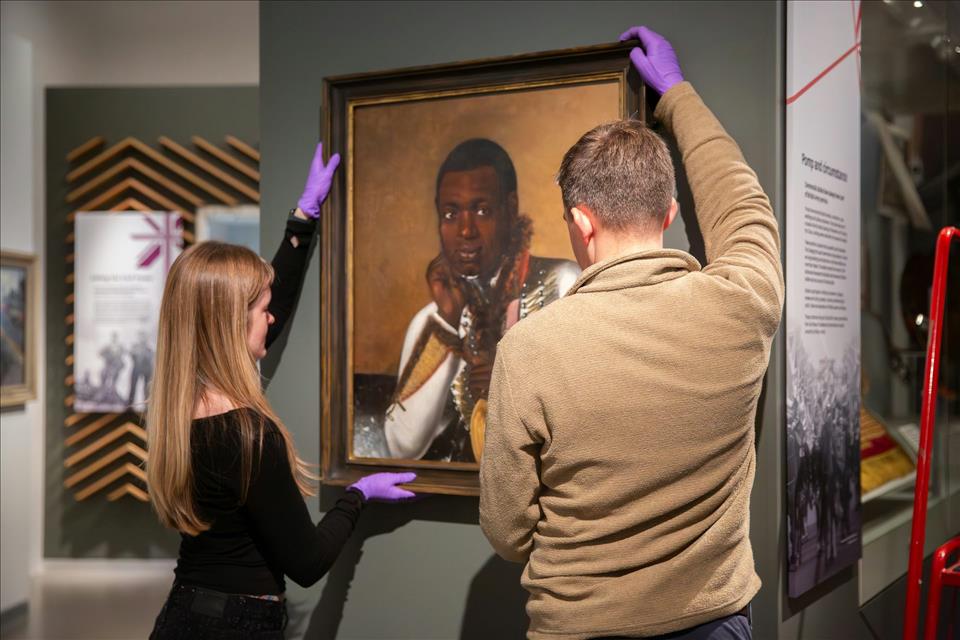
What A Newly Identified Portrait Of A Black Napoleonic Soldier Reveals About British Army Diversity
It is the wider social and cultural effects of those wars, however, that dominates current historical research. This includes the impact of those wars on attitudes towards race.
The National Army Museum in London has recently identified the likely subject of a portrait of a black soldier in its collection as Private Thomas James. Speaking to the Guardian to mark both the identification and restoration of the portrait, curator Anna Lavelle highlighted the British army as a place of racial equality. Meanwhile, the museum's director, Justin Maciejewski, suggests that the painting underscores the shared sense of purpose historically held by British soldiers when facing common enemies such as Napoleon.
The vast majority of ordinary privates who fought and died in the Napoleonic wars have left no record, irrespective of their ethnicity. This in itself makes the recent identification – though not with a 100% degree of certainty – of the subject of this portrait important. It might be taken as evidence for an argument already made by Napoleonic specialists: that the demands of war provided an opportunity for previously marginalised groups to improve their status.
This applied not only to enslaved men of African heritage, but to other groups including, for example, Jewish people in Central Europe who fought against Napoleon in the armies of Austria and Prussia. Like Irish Catholics in the British armed forces, they and their supporters used their patriotic engagement to justify greater equality in the emancipation debates that followed the end of the Napoleonic wars.
The painting of Private James Thomas, framed after restoration. Courtesy of the National Army Museum
James's experience was therefore far from unusual. Within the British armed forces of the time, the majority of black men served in the so-called West India Regiments, formed in the 1790s to fight the French in the Caribbean. These men were, in practice,“purchased” by a British government desperate for additional manpower. They served in an environment infamous for its horrendous attrition rates caused by tropical diseases. Whether this process can be heralded as a model of modern diversity and inclusion practices seems doubtful, to say the least.
That said, these black soldiers were by virtue of their military service freed from slavery. While wearing the king's coat, they were subject to military disciplinary codes that were ostensibly colour-blind, unlike the colonial codes that had previously regulated their lives.
From their perspective, the British military effort in the Americas undoubtedly led to an improvement in status. At the same time, vast investments in naval infrastructure in the Caribbean created new economic opportunities for freed black people – both women and men. These opportunities were especially significant in the islands of that strategically vital region.
There is a further dimension to the portrait of James. The white colour of his uniform deviates from that of most of the regiment, which would have been dark blue. Taken together with the prominently displayed cymbals, this suggests James was part of the military band common to regiments in all the armies that fought the Napoleonic Wars.
Music was a feature not only of ceremonial occasions but an important ingredient to good morale. It even played a role in communications. Black musicians were often prominent in military bands in this period, and not only in the British army.
The Charge of the Mamelukes by Francisco Goya (1814). del Prado
They were also common in the armies of German states even before the Napoleonic wars – somewhat surprisingly, given that these states, unlike Britain, did not possess any African or Caribbean colonies. The background to this fashion derives from the Ottoman origins of modern military music, and its adoption by European armies during the 18th century. Initially, western armies employed Turkish musicians in these bands, but over time they were replaced by men of African origin.
African musicians were much prized and respected. They added lustre to the regiment and prestige to the colonel. More widely, they fed into a wider societal demand for the“exotic”.
Within Napoleonic-era armies, this was manifested in the undue prominence given to military units that fed Orientalism – including, most famously, the Mamelukes of the Imperial Guard, who served close to the emperor himself, and who appear in almost every Napoleonic-era painting. Other examples include the Russian Cossacks, whose attire was so exotic that it inspired innovations in civilian fashion when the Tsarist army occupied Paris after Napoleon's defeat.
Armies reflect the societies from which they are drawn. And while Napoleonic-era armies provided unusual, if not unique, opportunities for those otherwise on the margins, they also reinforced notions of difference that were fairly common at the time.
Looking for something good? Cut through the noise with a carefully curated selection of the latest releases, live events and exhibitions, straight to your inbox every fortnight, on Fridays. Sign up here.

Legal Disclaimer:
MENAFN provides the
information “as is” without warranty of any kind. We do not accept
any responsibility or liability for the accuracy, content, images,
videos, licenses, completeness, legality, or reliability of the information
contained in this article. If you have any complaints or copyright
issues related to this article, kindly contact the provider above.


















Comments
No comment